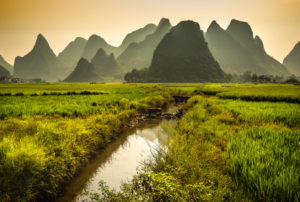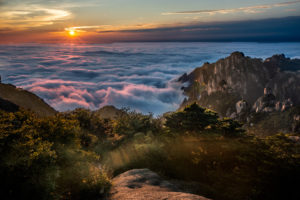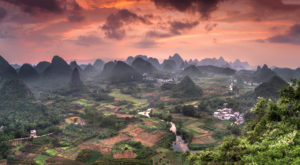Welcome dear reader to my China blog. Due to a combination of stubborn insistence that I shall go forth and photograph, a long-held passion to see the Yellow Mountains in China, and a total mix up between what I thought were the yellow mountains in the clouds beyond Huangshan , and the karst formations near Guilin, I am now embarking on a 2 week photographic trip in China, encompassing both. No tour groups, just me and my guide, and a million or so local tourists. What was I thinking?
All should have been wonderful, except on the evening prior to my 6:25am flight to Hong Kong, Pam and I found out from the local news that super cyclone Mangkhut (Thai for a mangosteen, a sort of little brown fruit, not at all like a cyclone), having birthed in the Pacific a few days ago with hardly any notice, had precipitously matured to a class 5 horror storm and was bearing down on Hong Kong in a ferocious frame of mind. Luckily it was not to arrive until after I left that city for Guilin, and the weather reports (and my guide) appeared to indicate it will hardly register in Guilin which is a long way inland. Looking at the cyclone tracking data I’m not so sure, but we all decided to go ahead anyway, so up at 3am, and onto the 6:25am Cathay Pacific flight up to HK.
My indulgence on my evening in HK was to dine at the Langham buffet seafood restaurant. This was my second choice after I found out that their Boston Seafood and Grill offered lobster at $200 a pop or a 300 gram eye fillet at $150. Whoa. The buffet was memorable in the grand oriental tradition. I was the only westerner there, and I went back to the buffet multiple times before my stomach muscles started to cramp. I carefully ignored the total of the bill when it came time to sign, and had one more plate of desert.
The next day was a travel day. A quick walk around the Kowloon harbour, then off to the airport to wait out my flight to Guilin. This evening finds me having finished a mediocre meal at the Aroma tea house hotel (memo – eat out tomorrow night), and then twiddling my thumbs in the comfortable but spartan room. Loneliness is going to be an issue. I hope Mercier is a bit of a raconteur.
Breakfast the next day was a buzz. A sweeping view and scrambled eggs. Bridges on the lake, disappearing to the karst mountains. and groups of middle aged nonas exercising to Chinese popular opera. Motor bikes with the whole family on them weaving around tourist buses. And all from the balcony while sipping a cup of very strong coffee. I knew they’d have a coffee culture here.
After breakfast I met my companion for the next 5 days, Mercier Zeng, a charming younger guy with good English skills. Without further adieu we piled into his Rav 4 and charged off to the first shoot location. This was in the countryside amongst the most magnificent set of low mountains, silhouetted and layered against unfortunately a cloudless and hazy sky. The light was interesting though. Then the hired help turned up in the guise of an old farmer and his water buffalo, both of which I dutifully photographed unfortunately into the light. It was growing hot, so after a visit to a famous stone bridge built by a rich farmer 200 years ago to celebrate his daughter’s betrothal, we high-tailed it back to Diaxu old town, to photograph Mr Zhou in his wonderfully atmospheric centuries-old house. The light was good. We’ll see how those turn out. Then off to a fine repast of noodles, dumplings, and potato pancakes washed down with copious quantities of green tea. Holy calories, batman. In the later afternoon, we returned to the same morning location, same farmer, same buffalo but much improved light for our final shoot. Much was discussed during the day and I think we’ll be mates, Mercier and me. Finally I went out for dinner to an establishment recommended by Mercier, and as an added bonus found a traditional Chinese orchestra playing some rousing pieces by the lake on the way back to the Aroma tea house.
We left the Tea House at a civilized hour the next morning, and rocked our way to the tunes of Dire Straights to the Longji rice fields, some 3 hours distant. Here around 300 years ago, the minority Zhuang people started building terraced rice paddies precipitously on the sides of mountains (the Dragon’s Backbone). The Zhuang were fleeing the Han majority who had declared open season on minorities. For over a hundred years they terraced the mountainsides and grew rice to feed themselves. The paddies are watered from the top by mountain springs, so as far as I can see their rice cultivation is an early example of trickle down economics. Republicans, eat your heart out.
We climbed to near the mountain-top up unending flights of rock stairs. Unfortunately, typhoon Mangkhut finally found us, and although at this stage it had shrunk to a tropical depression some 250km away, it still shook my room all night in the Green Forest hotel. The next morning it was spent, and I managed some photos of the rice terraces after dawn before the bloody rain set in. Going down in the rain with 8 kilos on my back was a little less exhausting but a lot more hairy than going up. We stopped to visit an elderly Zhuang couple in their house for an arranged photo session. Very gracious of them putting up with my imperious poseur commands translated by Mercier. A little to the right please, look up, damn there’s not enough light. Finally I collapsed in Mercier’s Rav 4 and we drove 3 hours to the tourist village of Long Shao in the karst mountains, to repose in the Mountain Nest hotel. Again another lot of charming hosts with half decent English.
As a small interlude, I must remark on the driving habits of Chinese. People don’t particularly speed, but no-one seems to care very much where on the road they drive. The smaller the vehicle; e.g. e-bikes (electric scooters), motorised tuk-tuk-type things, and motor bikes, the less traffic lights and the other vehicles on the road have any meaning. Buses will pass slower vehicles on blind bends. Cars will wander into the middle of intersections and then almost stop. And yet the freeways are organised, and cameras abound almost every 200 meters in some areas. I have so far seen no accidents, but more close shaves than I can count.
The next morning was a 3am start, in order to catch the sunrise over the karst mountains and Li river. I envisaged a small lookout and a few brave souls, but after 500 steps upwards, we came to a multi-tiered lookout and were joined by about 20 people. Mercier said that in high season there could be 200 with tripods bristling. The view was wonderful but the light was shit, and these images will not be making it onto my webpage.
After a breakfast of, you guessed it, noodles, and then a sleep, we travelled to the Li river to photograph several old fishermen and their assorted cormorants. These guys are over 80 years old, and once upon a time made their living fishing the Li river with their cormorants, before pollution and overfishing took its toll about 8 years ago. They have wonderfully sculpted faces and a charming demeanor. We photographed them at their home and on their boat on the river under difficult but interesting light until dusk, when the rain came in and forced the fisherman, Mercier and myself to share an intimate few minutes under an umbrella. Dinner was at an aptly named establishment called the Giggles Hotel, where the chef had the last laugh because I was violently ill that night from something out of place in the beef and potatoes stir-fry. Needless to say I missed the dawn cormorant fisherman shoot, which was just as well because the whole place had fogged in anyway.
I was well enough the next day to get on a plane and travel to Huangshan, the fabled Yellow Mountains, overnighting at the town of Huangshan (or Tunxi as it was originally called until it was deemed this was not touristy enough) in the Huangshan International, a behemoutb of a building with huge rooms and lousy aircon. My new guide Tony met me at the airport. He explained that the locals call this 2000 meter range the black mountains, but black is not a good colour in Chinese culture, so in 747 AD it was changed by imperial decree to Huangshan, or Yellow Mountains, in honor of Huang Di (the Yellow Emperor), a legendary Chinese emperor, and the mythological ancestor of the Han Chinese. One legend states that Huangshan was the location from which the Yellow Emperor ascended to Heaven. Another legend states that the Yellow Emperor “cultivated moral character and refined Pills of Immortality in the mountains”.
The Yellow Mountains are famous for tortuous mist-enshrouded peaks, pine trees clinging to cliffs, and the “sea of heavenly clouds” phenomenon. It is also a world heritage area. What they didn’t tell me is a lot of the time it rains and fogs. So after a car, bus and cable car journey into the mountains, we walked up to the Beihai hotel in the rain and fog, with visibility down to a few meters. This did not auger well for photography.
The next day was the same, so after we walked to our new hotel, (the Baiyun) I forced Tony to show me the sites, or at least where they were meant to be. But later, miraculously, the clouds cleared and I was treated to the heavenly sea of fog phenomenon at sunset. Very hard to photograph and I have not done it justice at all (I stuffed up the overexposed brackets on the images facing the sun), but I’m glad I saw it.
That evening the hotel put on a dragon, percussion group and popular singer extravaganza on the front steps, which helped to keep loneliness from the door. The next morning I was up at 5am to catch the sunrise and of course, you guessed it, it was foggy and raining. So after a really crap breakfast (the food at the hotels is lousy), we saddled up and walked 3km in the rain to the cable car along tortuous stone steps.
Huangshan is unique for many reasons. Everything that supports the tourist industry there – building materials, food, laundry, garbage, overweight tourists – is carried up and down by porters, usually in loads over 50kg, suspended on bamboo poles, at a rate of 5 yuan (about a $) per kg. The government owns all the hotels and does not allow goods transport on the cable cars, to preserve the porter’s livelihood.
The mountain supports colonies of Tibetan macaques, but when tourists continually ignored signs imploring people not to feed or tease the monkeys, the government simply caught and relocated these territorial monkeys into the valleys. This is a profound metaphor for Chinese problem solving, behaviour and nation building. I witnessed a crew spraying pesticide over the forest with the hoses leaking everywhere – in a world heritage environment. The government employs firemen on the mountain – who look like security people – to make sure people don’t smoke. A butt thrown away caused a big bushfire about 10 years ago. They also employ people to walk the 50km of stone steps, brushing leaves off them. I kid you not.
So tonight, Saturday, back at the Huangshan International, Tony insisted I go get a Chinese massage, which defined new meanings for the term pain. No I exaggerate, the 1-1/2 hour massage made a new man of me. With my stomach returning to normal, I even managed a hearty repast of soya steamed whole fish and stir-fried vegetables that evening.
On Sunday we visited to UNESCO world heritage villages Xidi and Honcun for some street photography. On the way, Tony explained that the Hui culture is known for its architecture, food, and agriculture and business acumen. The architecture, notable for its dividing walls, ornate roofs and white housing, is mandated throughout the region of Anhui. Housing is still built to the principles of Feng Shui, and the older farming communities still believe in the old religion. Interestingly, when Tony was born, his parents consulted with an astrologer, who noted that out of the key elements; water, fire, earth, wood and gold; one element, namely water, was missing. So they advised them to include this in his name to balance his Yin-Yang, which was given as Shanghi, where hi is the word for an ocean – plenty of water indeed. So Tony’s full name is Shanghi Lee, which sounds sort of like an 18thcentury Chinese gangster.
Xidi and Honcun are as old as 1000 and 600 years old respectively, and a little underwhelming, full of tourists and tourist shops, though Xidi contained a number of craftsman shops selling ink painting paraphernalia and beautiful pictures carved on bamboo screens. Not much photography here though.
Then the next morning a mind numbing 7-1/2 hour 2 train journey (even at speeds up to 300km/hr) back to Guilin, and the Aroma tea house, because the bloody flight was cancelled. At this stage I was over it all, but the next and penultimate day, a new guide, Dennis, took me up into the hills for a walk through yet another village and then sunset at a vista overlooking the karst mountains, with OK light and a good sunset. I think I have some interesting shots of people lit in doorways, and a passable panorama at the sunset spot.
And so my adventure ended next day with a rainy 130km/hr taxi ride in 80km/hr zones to the airport, and flights to Hong Kong and then Adelaide. And as I record my last words here, I reflect on how we landscape photographers are so much at the mercy of the elements, and how the gods are sometimes kind and often not. Despite the best and considerable efforts of Mercier Zeng and his cohort of guides, so it was this trip. I will extract what I can, and move forward from the opportunities missed.




The sample shots here are nothing…short of magnificent! Look forward to further exposition!